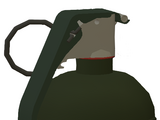
Grenades are throwable explosives that mainly rely on a calculated arc to land accurately. A grenade can be accessed by any class in-game, however, only a maximum of three can be held at any one time per life. Furthermore, the thrower can be killed by their own grenade (excluding non-damaging ones); this is the only weapon that is able to do this.
History[]
The first historical usage of grenades, oddly enough, predates the discovery of gunpowder itself. The first recorded usages of what could be described as "early rudimentary grenades" was during the reign of Emperor Leo III in the Byzantine Empire (717 - 741 AD). Byzantine soldiers would learn that the mythical Greek Fire, an ancient flammable mixture from the 3rd Century AD. They discovered that not only could it be shoot in a stream from a flamethrower, but they also discovered that they could fill stone, glass or ceramic jars with it to use as grenades.
However, it wouldn't be until the 9th Century AD that, in Song China, gunpowder would be discovered and, soon enough, utilized for the creation of "Thunder Crash Bombs" (震天雷), which were ceramic or metal containers that were filled with gunpowder and fitted with a fuse.
From Persia to Europe, grenades would be mostly consisting of ceramic jars filled with explosive compounds until the late 15th century, when the first cast-iron bombs were made in Medieval Europe, for use against besieged castle walls.
It wouldn't be until the 17th and 18th centuries that grenades would take a major role in warfare, as European armies filled their ranks with grenadiers, soldiers trained in the usage of cast-iron bombs, ceramic grenades and all other types of explosives.
Grenadiers would become a staple of European warfare but lose their relevance as warfare modernized during the 19th century. By the time of the American Civil War, grenadiers were pretty much gone, as Union soldiers were provided with the Ketchum Hand Grenade in order to flush out Confederate soldiers out of their defenses. Similarly, during the Crimean War, British Troops would often use improvised grenades against the Imperial Russian troops.
Modern grenades wouldn't really appear until the 20th Century, as a product of the European Arms Race that preceded the First World War. As the German Empire developed more refined and effective grenades, the allies raced to catch up, leading to several innovations, as well as the application of certain new technologies such as the military application of TNT and the invention of the percussion fuse, which is the type of fuse found in most grenades from this point forward.
It would also be during World Wars that new types of grenades would be deviced, such as the Fragmentation Grenade (The British Mills Bomb being the first in 1915), High Explosive Concussion Grenades, Anti-Tank Grenades and, most famously, Gas Grenades that facilitated the deployment of chemical weapons such as Chlorine or Mustard Gas, as well as Incendiary Grenades; which could be either Improvised, like with the Molotov Cocktail, or purpose-made, like the British No. 76 "A.W" bomb, also known as the SIP (Self-Igniting Phosphorus) Grenade for its usage of White Phosphorus.
During the Cold War, as social movements sprung up across the world, new types of less-lethal grenades would be devised like the Stun Grenade, which wouldn't explode but rather blind and deafen targets within its radius, or the Tear Gas Grenade, meant to disperse rioting crowds.
In-Game[]
General Information[]
Grenades, as stated above, are applied by throwing them at or near targets. However, grenade mechanics bring some interesting gameplay, greatly differentiating them from conventional firearms. The three main mechanics are:
- Grenades are greatly affected by gravity, resulting in a much greater amount of arc than bullets, and a limited range.
- There is a 'blast radius' to grenades, damaging any who can be hit by fragments out to a certain distance from the grenade; in comparison, bullets only travel in a somewhat straight line.
- Grenades have world physics, as they can bounce off the environment and other players, compared to bullets, which can only penetrate or not penetrate objects.
All grenades (with the exception of the M14 Smoke and Impact Grenades) rely on a timed fuze, exploding and causing damage after the elapsed time. Grenades can be 'cooked' by continuously holding down the throwing key (G to throw a grenade), lessening the time it takes to explode after thrown, however, they can explode and kill the user if held for too long.
Usage & Tactics[]
Grenades perform well in a short to medium range, as any closer, and they may pose a threat to a thrower, and they cannot be thrown much further (however, the V40 Mini has a greater effective range). As they can explode, causing damage to the surrounding area, this makes grenades effective for clearing out areas with many enemies, either by directly killing many with the explosion, or flushing them out away from the grenade and into oncoming fire.
Grenades can be also be used as traps—if there is an enemy pursuing the thrower, a well-placed grenade can result in the enemy unknowingly moving near the grenade, and getting killed.
Finally, grenades can be utilized for their physics. Often, a grenade is thrown at a near-45° angle, and when accompanied by player movement, this can enhance the throwing distance, and can land the grenade behind walls and into enemy cover. This is sometimes more useful than attacking the area with a firearm, even with a light machine gun. Furthermore, grenades can be rebounded off other objects to get into difficult areas, for example, around corners, or into tight areas, useful for when one does not know if there is possibly an enemy lying in wait.
Certain grenades have different capabilities. The most well-known out of all grenades, the Frag is a jack-of-all-trades weapon, with a moderate arc and throwing distance, blast radius, and a 5 second fuze. The V40 Mini is a smaller variant, resulting in a much longer throwing distance and flatter arc, but with a reduced blast radius. The RGD-5 is a more close-quarters-combat (CQC) oriented grenade, with a 3 second fuze and a high throwing arc, useful for assault tactics.
Finally, the M14 Smoke is a non-damaging smoke grenade, releasing a thick cloud of smoke upon its explosion. This is useful for creating immediate cover (however, smoke is not impermeable to gunfire) or assaulting targets and misdirection.
Conclusion[]
The variety of grenades available to use allows one to select very situationally. Assault tactics, target flushing, long-distance suppression and defensive cover are all an option in the wide roster that grenades can be applied for, as well as grenade arc and rebound, however, they are limited by the amount of grenades available on the user at any one time.
All items (9)





















